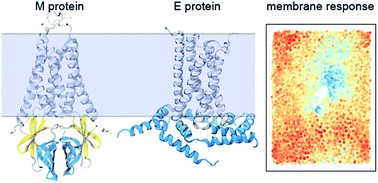Molecular interactions of the M and E integral membrane proteins of SARS-CoV-2
Abstract
Specific lipid–protein interactions are key for cellular processes, and even more so for the replication of pathogens. The COVID-19 pandemic has drastically changed our lives and caused the death of nearly four million people worldwide, as of this writing. SARS-CoV-2 is the virus that causes the disease and has been at the center of scientific research over the past year. Most of the research on the virus is focused on key players during its initial attack and entry into the cellular host; namely the S protein, its glycan shield, and its interactions with the ACE2 receptors of human cells. As cases continue to rise around the globe, and new mutants are identified, there is an urgent need to understand the mechanisms of this virus during different stages of its life cycle. Here, we consider two integral membrane proteins of SARS-CoV-2 known to be important for viral assembly and infectivity. We have used microsecond-long all-atom molecular dynamics to examine the lipid–protein and protein–protein interactions of the membrane (M) and envelope (E) structural proteins of SARS-CoV-2 in a complex membrane model. We contrast the two proposed protein complexes for each of these proteins, and quantify their effect on their local lipid environment. This ongoing work also aims to provide molecular-level understanding of the mechanisms of action of this virus to possibly aid in the design of novel treatments.

- This article is part of the themed collection: Peptide-membrane interactions


 Please wait while we load your content...
Please wait while we load your content...